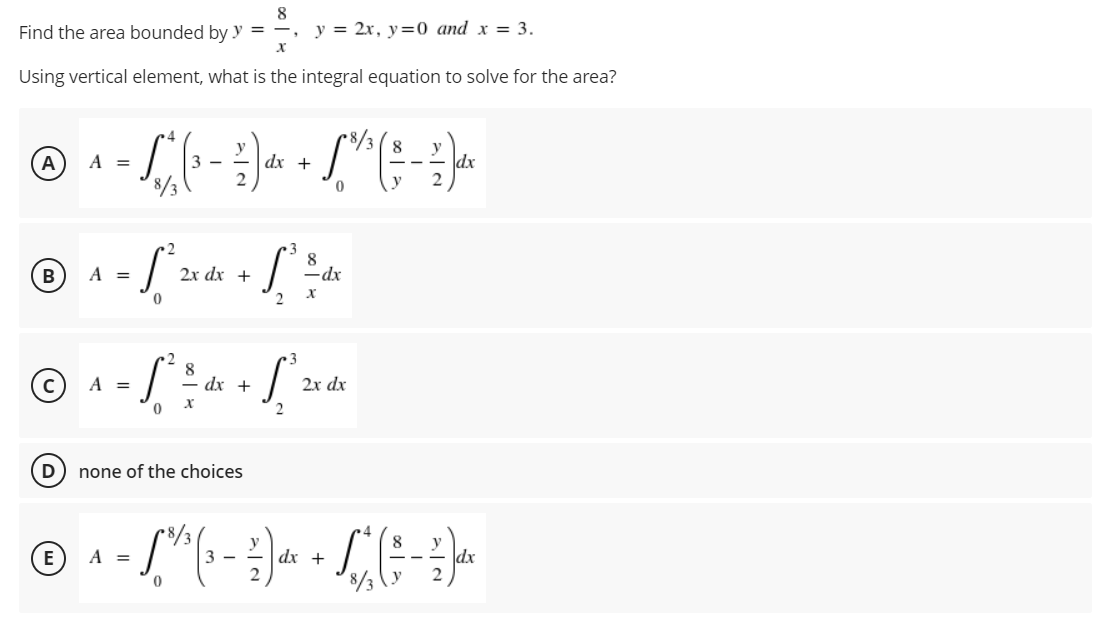8 Find the area bounded by y=-, y = 2x, y=0 and x = 3. X Using vertical element, what is the integral equation to solve for the area? A A = · L^, (₁ - ² ) dx + £^" ^¹ (² - ² ) dx 2 0 3 S²³2x dx + ² = d 8 B -dx 2 x 3 S² = 4x + √5² 2xd A = 0x (D) none of the choices 8/3 E A = · S^³/³ (³ - ² }) dx + £^* ( ²3 - ² ) ¹²x (3 dx 2 = A = 8 = dx
8 Find the area bounded by y=-, y = 2x, y=0 and x = 3. X Using vertical element, what is the integral equation to solve for the area? A A = · L^, (₁ - ² ) dx + £^" ^¹ (² - ² ) dx 2 0 3 S²³2x dx + ² = d 8 B -dx 2 x 3 S² = 4x + √5² 2xd A = 0x (D) none of the choices 8/3 E A = · S^³/³ (³ - ² }) dx + £^* ( ²3 - ² ) ¹²x (3 dx 2 = A = 8 = dx
Functions and Change: A Modeling Approach to College Algebra (MindTap Course List)
6th Edition
ISBN:9781337111348
Author:Bruce Crauder, Benny Evans, Alan Noell
Publisher:Bruce Crauder, Benny Evans, Alan Noell
ChapterA: Appendix
SectionA.2: Geometric Constructions
Problem 10P: A soda can has a volume of 25 cubic inches. Let x denote its radius and h its height, both in...
Related questions
Question
Find the area bounded by

Transcribed Image Text:8
Find the area bounded by y =
y = 2x, y=0 and x = 3.
X
Using vertical element, what is the integral equation to solve for the area?
y
8
y
A
A =
- S, " ( ₁ - ² ) d x + 6 " ^ ( - ²2 ) dx
3-
dx
0
3
8
- [² 2x dx + ² = d
-dx
0
2 X
8
• S² = = dx + 1² 2x d
A =
S
-
dx
X
0
D none of the choices
E A =
· [²/³ (₁ - ² ) dx + L ² ( 5 - 2²7) dx
(3
3-
0
B
A =
Expert Solution
This question has been solved!
Explore an expertly crafted, step-by-step solution for a thorough understanding of key concepts.
Step by step
Solved in 2 steps with 2 images

Recommended textbooks for you

Functions and Change: A Modeling Approach to Coll…
Algebra
ISBN:
9781337111348
Author:
Bruce Crauder, Benny Evans, Alan Noell
Publisher:
Cengage Learning

Functions and Change: A Modeling Approach to Coll…
Algebra
ISBN:
9781337111348
Author:
Bruce Crauder, Benny Evans, Alan Noell
Publisher:
Cengage Learning